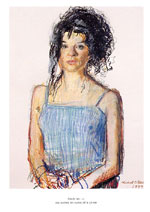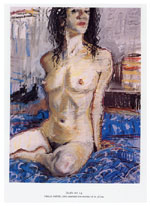Édaín
An Exhibition of work by Mick O'Dea (1999)
Mick O'Dea took the decision to hold an exhibition of drawings and paintings as a result of conversations he had with fellow painter Édaín O'Donnell in the autumn of 1998. He had returned from Spain where he had been awarded an M.A. in European Fine Art after a year of study in Barcelona. There he had been developing, along with larger scale works, the familiar theme of his toy soldiers series. Earlier in 1998 he spent a period of time in County Mayo at the Ballinglen Arts Foundation making landscapes and seascapes. His original intention was to exhibit these works upon their completion. This plan was to be put on hold however when the idea for a collaboration of figurative works was proposed.
Édaín O'Donnell is among other things, a figurative painter for whom O'Dea has a high regard. He maintains that she has an empathy and a sympathy for the figure and he values her critical judgements very highly. In considering the proposal to work together on a series of drawings and paintings he felt certain that her critical input into the project would ensure the avoidance of what he dislikes most in this genre of work -the sins of irrelevance, sentimentality and romanticism.
He has of course shown exclusively figurative work on a number of occasions, the most recent being in the Taylor Gallery in Dublin in 1989. What makes this present exhibition different however is the nature of the engagement between the artist and the model. O'Dea has little sympathy for what he considers to be the excesses of late nineteenth century academic Romanticism. According to him this view tended to promote a stolidity which originated in the life drawing class ethos and had the effect of objectifying the figurative model. It did not allow for, nor did it encourage an immediacy of engagement and most particularly it did nor countenance the possibility of interactive responses. This exhibition seeks to redress that dynamic imbalance and in so doing, facilitate a reappraisal of the nature of the relationship between artist and model. There is also an extra dimension of this enterprise to be considered. Édaín O'Donnell's role is not only that of model. She is also concerned as an artist, one whose assumed role, as model, is every part as active as that of the Painter in negotiating situations and responses.
As in most things he does O'Dea displays considerable singularity of purpose in his approach to the conceptualisarion and realisarion of this exhibition. In all aspects of his creative activity, he is constantly at pains to stress the point that it is engagement with a living form, either a human being or an aspect of nature that brings out the strength of his work. There is ample evidence in support of this in his landscapes and his portraits, in the latter case most notably the Thom McGinty [Diceman] studies readily come to mind. This present work shows him poised to explore the psychological dynamic of working closely with somebody else. In so doing he believes that the effort of harnessing that dynamic enables him to generate a sense of urgency in his work which is translated and made manifest by the quality and the immediacy of the marks made in the process. In effect he seeks to explore the dynamics of creativity itself, and suggests that the experience is akin to a western variation of an eastern Zen theme.
He makes the comparison with the activity of the eastern calligrapher, who can seize the correct moment to make the appropriate mark with complete assurance and skill. One senses also that there is another minor agenda at work here. O'Dea has a very strong sense of the history and tradition of his craft. None of his images could ever be termed as photo realist nor are they technologically based or generated. He has no tolerance for what he regards as 'lazy naturalism', lacking as itdoes, he believes, a sense of urgency. His tradition, as he sees it, harks back to the Northern Renaissence and is essentially Humanistic in approach. If there is an additional imperative in these works it is concerned with updating in late twentieth century Ireland, aspects of that ethos which he clearly espoused in his earlier involvement with the Independent Artists group.
The exhibition is consciously composed in terms of subject and content. It consists of thirty drawings and paintings. The pastel drawings are stand alone images, and should not be regarded as preparatory studies for the paintings. O'Dea sees himself as primarily a draughtsman. He regards drawing as a gateway medium, with its own integrity, enabling expression in other media. When working in paint he does not make preparatory sketches preferring to work directly with that medium. At the moment he has a preference for acrylic paint which, because of its drying properties facilitates the immediate draughting aspects of his work.
The subject of the show is not as one might expect, the Artist's model. More particularly the subject is concerned with the Artist and the Model. Inevitably one has to consider the psychology of the portrait and all that this entails. There is very little doubt that O'Dea is on familiar ground here and will cite, where appropriate, the antecedent virtues of artists like Kokoschka in this area. He does assert however that he is not unduly concerned in this instance with making a case for the psychological value of his work. The empathy that exists between the artist and the model is undoubtedly crucial. In basic terms he is a man looking at a woman. However given the nature of the relationship that has been set up between the artist and the model he is now forced to confront and re-evaluate the way he looks at women. He cannot be voyeuristic. She cannot be objectified. One cannot be dominant, the other subservient. They will meet together as equals in the middle ground.
The content of the work, concerned as it is with the dynamic of the exchange between them, translates essentially into a set of statements about process. O'Dea tends to work in an immediate manner striking in context for the appropriate mark whenever possible. He does not have a preference for protracted and laborious studies. In this way he usually sets up and controls his own situational responses. In this instance the situation is altered. His responses are now critically mediated by an engagement with another artist. Each study reveals the progress of differing sets of social interactive and creative imperatives.
The work as a whole reflects both the artist's and the model's varied temperamental responses to working together over a period of months. Variability of circumstance determines the nature of the personal interaction which in turn impacts on the selection and deployment of media. This is at the heart of the artist's intentions. Each study is at once energetic and contemplative, multi directional yet focused, coloured sparingly yet luxuriant and never inherently contradictory. In this exhibition O'Dea has charted the progress of a collaboration of like minds. He sees himself as being firmly in the academic tradition but nor in the classical sense. Classical academic drawing and painting he feels, did ensure a certain rigour but ultimately, perhaps because of the way it was taught, had a stifling effect in the long run. There is a different though no less valid rigour of expression evident in these works borne out of the varying creative demands of the media. Some may point to comparable attributes in the work of Auerbach or Schiele. In terms of an overall tradition those artists could never be accused of lazy naturalism. To a certain extent one senses that O'Dea might not have too many difficulties with that suggestion.
Gerry Walker
NCAD, February 1999

